For Sponsors and Licencees, the Praaktis Exercise Engine® can provide the core of any motion capture and analysis smartphone application they wish to support or develop. It consists of an ever expanding number of Routines, and documented APIs enabling easy integration into any smartphone application (iOS or Android).
At a point in the User Journey of the App, the Exercise Engine® takes control of the smartphone camera and uses proprietary, patented software to
- Ensure that the user is correctly positioned in the video
- Track the motion of the user throughout the Routine
- Measure relevant distances, angles and speeds of motion (*)
- Compare the measurements for the user against the ideal performance to produce a score for the user every time they complete a Routine (*)
- Count the number of successful repetitions within a Routine
- Time a period in which the User is stationary in a correct position within a Routine
- Provide details of sub-scores on different elements of performance for more detailed analysis and hints for improvement
- Provide details of the User, their location, scores and sub scores to a database for comparison, analysis, reward calculation and presentation
(*) Where possible Expert input from experienced trainers, coaches and other professionals is built into the Measurements
Routines
1. Jump From Stool - Front
Who for: Physiotherapists and sports coaches What it measures: The natural landing position and the flexibility of a player/patient prior to, at and post impact with the ground from the front (including knee valgus, trunk flexion, symmetry etc.) Used for: Assessing vulnerability to knee injury; confirm fitness to train/play; manage/measure rehabilitation progress
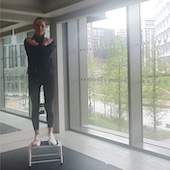
2. Jump From Stool - Side
Who for: Physiotherapists and sports coaches What it measures: The natural landing position and the flexibility of a player/patient prior to, at and post impact with the ground from the side (including trunk, thigh and shin positioning etc.) Used for: Assessing vulnerability to knee injury; confirm fitness to train/play; manage/measure rehabilitation progress
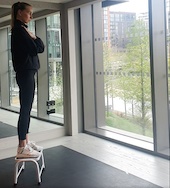
3. Two-legged Squat - Front
Who for: Physiotherapists, personal trainers, gym instructors, sports coaches What it measures: Stability and balance (including knee valgus, shoulder and hip stability, trunk displacement etc.) Used for: Assessing vulnerability to knee injury; confirm fitness to train/play; manage/measure rehabilitation progress
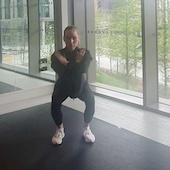
4. Two-legged Squat - Side
Who for: Physiotherapists, personal trainers, gym instructors, sports coaches What it measures: Stability and depth of squat achieved (including trunk and shin to vertical and thigh to horizontal at lowest point etc.) Used for: Assessing vulnerability to knee injury; confirm fitness to train/play; manage/measure rehabilitation progress
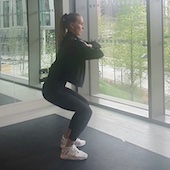
5. Standing Jump - Front
Who for: Physiotherapists and sports coaches What it measures: The natural landing position and the flexibility of a player/patient prior to, at and post impact with the ground from the front (including knee valgus, trunk flexion, symmetry etc.) Used for: Assessing vulnerability to knee injury; confirm fitness to train/play; manage/measure rehabilitation progress
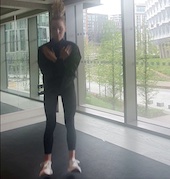
6. Standing Jump - Side
Who for: Physiotherapists and sports coaches What it measures: The natural landing position and the flexibility of a player/patient prior to, at and post impact with the ground from the side (including trunk, thigh and shin positioning etc.) Used for: Assessing vulnerability to knee injury; confirm fitness to train/play; manage/measure rehabilitation progress

7. One-legged Squat - Front
Who for: Physiotherapists, personal trainers, gym instructors, sports coaches What it measures: Stability and balance (including knee valgus, shoulder and hip stability, trunk displacement etc.) Used for: Assessing vulnerability to knee injury; confirm fitness to train/play; manage/measure rehabilitation progress
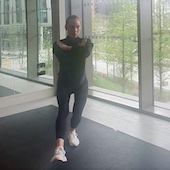
8. One-legged Squat - Side
Who for: Physiotherapists, personal trainers, gym instructors, sports coaches What it measures: Stability and depth of squat achieved (including trunk and shin to vertical and thigh to horizontal at lowest point etc.) Used for: Assessing vulnerability to knee injury; confirm fitness to train/play; manage/measure rehabilitation progress

9. Two-legged Squat – Form Score and Count
Who for: Personal trainers, gym instructors, sports coaches What it measures: Overall stability during the squat. Based on stability measures for hip, shoulder and trunk provide aggregate overall Form Score as well as counting all repetitions that achieve a score above a given threshold Used for: Validating that exercises have been properly completed. Part of training regime

10. Arm Stretch – Form Score and Count
Who for: Physiotherapists, gym instructors, sports coaches What it measures: Ability to raise both arms at the same speed to a suitable position above the player/patient head. Based on speed, symmetry and extent of raise provide aggregate overall Form Score. Count all repetitions that achieve a score above a given threshold Used for: Measuring progress of rehabilitation and validating proper completion of exercises

11. Bicep Curl - Form Score and Count
Who for: Personal trainers, gym instructors What it measures: Stability of arm during motion, angle at elbow at maximum curl. Based on stability and curl provide aggregate overall Form Score. Count all repetitions that achieve a score above a given threshold Used for: Validating that exercises have been properly completed. Part of training regime

12. Backward Lunge - Form Score and Count
Who for: Personal trainers, gym instructors What it measures: Based on stability lunge extension provide aggregate overall Form Score. Count all repetitions that achieve a score above a given threshold Used for: Validating that exercises have been properly completed. Count as part of training regime

13. Forward Lunge - Form Score and Count
Who for: Personal trainers, gym instructors What it measures: Based on stability lunge extension provide aggregate overall Form Score. Count all repetitions that achieve a score above a given threshold Used for: Validating that exercises have been properly completed. Count as part of training regime
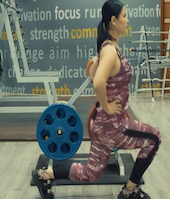
14. Boxing Jab
Who for: Boxing coaches, personal trainers, gym instructors What it measures: The angle of knee bend, angle of leg split, straightness of jab using elbow angle etc. Used for: Training amateur boxers and personal fitness exercise
